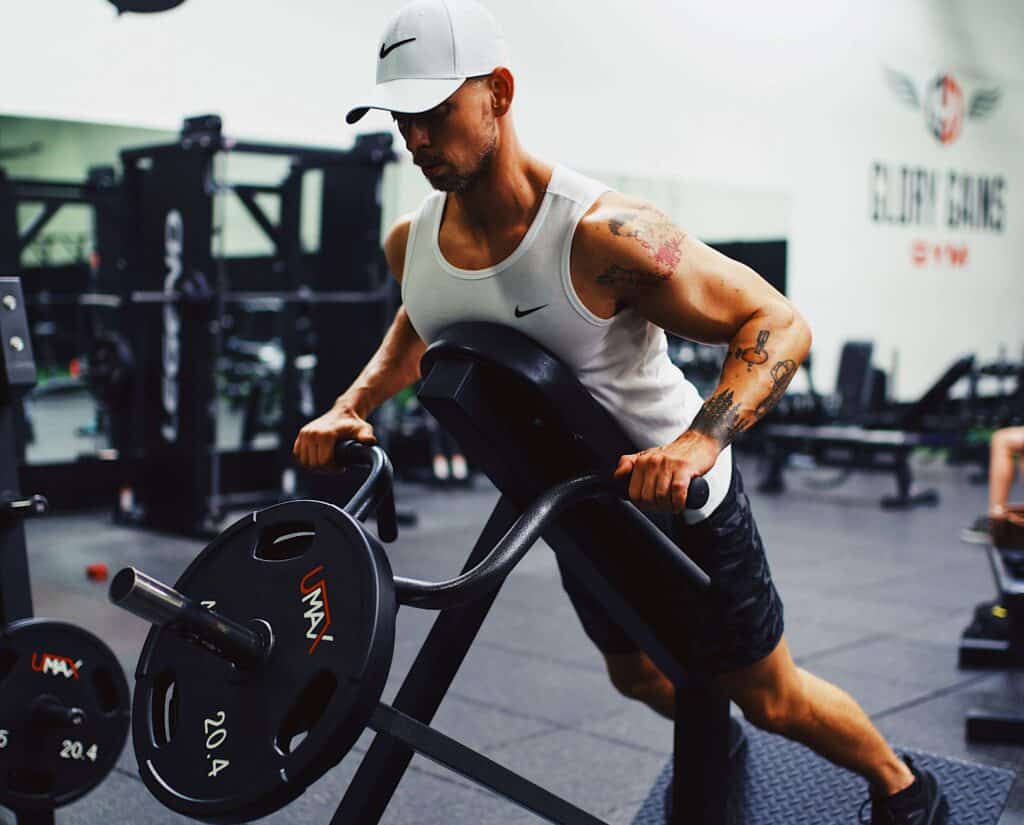
Muscle growth requires adequate workout volume, a significant load, and perhaps most importantly, mechanical tension. Mechanical tension is a fancy way of saying that an exercise should be performed through a full range of motion, with proper form, and enough resistance placed on the muscle.
Stimulus to fatigue ratio is the balance between the amount of tension put on a muscle from an exercise (stimulus) compared to the effort required to perform the movement (fatigue).
As a lifter becomes more advanced, they learn to feel the contracting muscle and control the eccentric (stretch) part of the exercise. They’re training with purpose rather than just throwing weight around.
Ideally you would want to choose exercises that stimulate the muscle effectively, but do not cause a great deal of fatigue. Too much fatigue can negatively impact exercises that come later in the workout, forcing you to perform them at a suboptimal level.
Since intermediate and advanced lifters require more workout volume and higher training frequency, they can’t afford to burn out after a few sets.
How Do You Know if an Exercise Has a Good Stimulus to Fatigue Ratio?
There’s no math equation to determine a good stimulus to fatigue ratio exercise, but there are a number of factors to look out for.
Muscle Pumps
If you can get a pump without spamming a bunch of reps to get there, the exercise probably has a good stimulus to fatigue ratio. We usually gravitate towards these exercises anyway because; who wouldn’t want a good pump at the gym?
Blood carries oxygen and nutrients to the muscle being worked. If you can get a good pump, this is a good sign for muscle growth in the long term.
Mind-Muscle Connection
If you work out long enough, eventually you develop an idea of movements you connect with versus movements you don’t. It’s great to try new exercises, but if you’re just not feeling it after awhile then don’t be afraid to remove it from your routine.
Mind-muscle connection may seem like unscientific bro jargon since it’s hard to quantify, but there’s something to be said about an exercise that you can feel.
Delayed Onset Muscle Soreness (DOMS)
While muscle soreness is not necessarily a direct indicator of muscle growth, it’s a pretty good sign that the exercise is working for you. So long as the soreness is not for weeks on end, where significant muscle breakdown likely occurred, a few days of soreness is probably a good thing.
In some instances, you may lack a mind-muscle connection during the exercise, but feel sore in the right places afterward.
Joint and Muscle Pain
Joint and muscle pain are an unfortunate byproduct of lifting, especially in the long run. But if you find that specific exercises are the culprit, then you can eliminate them from your routine. Any exercise that causes pain can be thought to have a poor stimulus to fatigue ratio.
This can be different for everybody. We all have knocks that flare up from different exercises. The important thing to remember is that you don’t have to perform an exercise just because everyone else is.
Don’t listen to the dogma surrounding what people consider to be the “best” exercises. Everyone squats because it is considered the holy grail of leg exercises. But if squats always leave you with knee and lower back pain, find a substitute.
Every exercise has some sort of alternative. If you don’t like squats, try hack squats, lunges, or leg presses. If barbell bench presses hurt your elbow, try dumbbells, machine presses, or flyes for chest.
Excessive Full-Body Fatigue
If you perform a hard set of curls, you will likely feel a burning sensation in the biceps muscle itself. The biceps will get a good pump and the muscle will feel tight, but it won’t leave you feeling exhausted.
A few sets of deadlifts, however, can completely drain you and affect all the subsequent exercises in your routine for that day. Generally speaking, conventional deadlifts are one of the worst stimulus to fatigue exercises since they generate a ton of fatigue and are subpar at targeting muscles for growth.

Optimizing Stimulus to Fatigue Ratio
Given what we’ve discussed so far, you may be thinking that you should choose a bunch of isolation movements and machine exercises to satisfy all the checkpoints for the stimulus to fatigue ratio.
This is not the case. Compound exercises can place a unique tension on the muscle that cannot be replicated with machines or easier movements. While they may generate more fatigue, this is okay because the stimulus is so great.
Advancements in exercise science literature have led to a trend of over-optimization. Thus, people have lost the value of putting in maximum effort in the gym. They spend more time meticulously trying to perfect every single thing they do. What usually happens is they end up doing nothing; not training hard enough to elicit growth.
Not every aspect of your routine will be perfectly rooted in science. Use the concept of stimulus to fatigue ratio to decide between exercises. If you need a rowing movement and it’s between a barbell bent over row and a seated cable row, ask yourself a few questions.
Which exercise delivers a better pump? Which exercise causes less pain? Am I able to connect with the movement?
This goes for any muscle group and any collection of exercises. As mentioned, it’s never going to be perfect. You’re going to bite the bullet on some really difficult exercises because the stimulus is so significant.
A good rule of thumb is that it’s better to sacrifice fatigue in favor of a stimulating movement. Hack squats are tough, but if they give your quads a burn like nothing else, keep them in your routine.
Sacrificing the stimulus never makes sense. If you’re not feeling the exercise and it isn’t delivering results, there’s no point in doing it if your goal is to build muscle.
You may be wondering why there isn’t a list of the best and worst stimulus to fatigue exercises. Aside from a select few examples (i.e. deadlifts generally not being the best choice), I can’t tell you what works for you and what doesn’t. A movement that is a staple in my routine may not work for you and vice versa.
As a responsible lifter you should give everything a fair chance, but don’t let anyone tell you what a good or bad exercise is. Your routine will be based on your unique body type, experience, mobility, along with countless other factors.
Recent Posts
If you were to ask someone about their first experience taking a pre workout, it may spark nostalgia depending on the era of supplementation in which it occurred. Products like Jack3d, SuperPump 250,...
As the fitness industry continues to boom, goods and services related to diet and exercise continue to grow as well. One such service is meal prep delivery. Meal prep delivery services cook meals...
